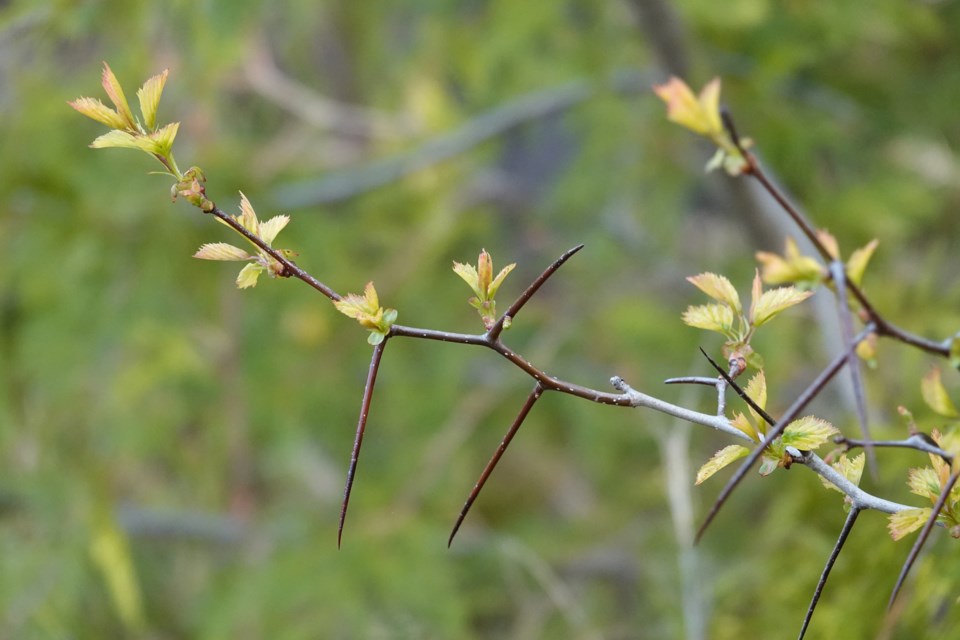Both my index finger and thumb hurt. It’s my own fault, I guess, as the leather gloves I used to pull out some gooseberry shrubs have a hole in the exact same places! Go figure.
And I should have known better than to grasp these thorny stems without 100% protection, as in previous years the same thing has happened (maybe I should get new work gloves ... but the other eight fingers are still in good condition).
Part of the challenge in dealing with thorny plants is, well, how to deal with the thorns. Whether it be a hawthorn shrub or a gooseberry stem, their protective thorns are there for a reason. You know, for protection of the plant.
If you are engaged in the fine craft of gardening or landscaping, sooner or later a prickly challenge shall present itself: roses, raspberries, nettles, hawthorns and the above named gooseberry will readily and efficiently defend themselves. Are you brave enough to continue your land clearing project?
These little prickers can cause you peril either physically or chemically, and sometimes both ways. Consider the common hawthorn shrub, a tough little treelet by anyone’s terms, that comes with long strong thorns (about finger-length) with a really, really sharp point. Getting stabbed by one of these things is easily a case for taking the rest of the day off.
The insult to injury provided by a hawthorn is that the thorn is covered in a histamine which causes an immediate burning sensation around the wound site. Not satisfied with just hurting you with the jab, the hawthorn ensues you learn your lesson by creating an agonizing burn around the wound.
Gooseberries are kind of the same, only different. Their thorns are quite plentiful, and small to point of being almost microscopic. But tough, being able to easily penetrate leather work gloves (even ones with all the fingers still covered). Like the hawthorn, these things hurt going into our skin but then ad their own little twist to the pain department.
The itty bitty thin gooseberry thorn is actually hollow, with an irritant loaded inside. When you grab the stem firmly and begin to pull it out, the sharp thorns imbed and break off, each one releasing a painful histamine that acts like a toxin to your nerves. Now comes the hot burning affect, followed by a week or two of having a teeny-tiny imbedded thorn sliver within your fingertip (did I mention this happened to me ... index finger and thumb ... here, let me show you).
This injection type of protection is also famous with stinging nettle, only with a hundred-fold more thorns per plant. Many in number are the hapless humans who have wandered into a summer patch of nettle wearing only shorts and a t-shirt. Woe be unto them!
Roses and raspberries are usually content to just rip your skin open.
If you do have a negative encounter with any of the above identified thorny issues, be sure to clean the wound with warm water and soap. Sometimes, a cold water compress will help to relieve the wound.
As mentioned, these sharp attributes are for the plant’s protection, to stop deer, cattle, rabbits and groundhogs from eating them. This way the unmolested plant grows to maturity and produces a crop of fruits.
Hawthorn shrubs have been utilized by a variety of wildlife, particularly birds, as a perimeter of defense around their nests. The thorns provide a very good bastion of defense from egg-stealing crows and blue jays, as well as marauding raccoons and red squirrels.
Hawthorn nesting sites are preferred by brown thrashers, catbirds, rose-breasted grosbeaks and perhaps the most famous of them all, the loggerhead shrike. However, interestingly and strangely, the shrike population is crashing while hawthorn establishment in abandoned fields is growing.
Another group of hawthorn users are the faeries, especially those which live within Celtic legends. Hawthorn shrubs were reported to be the very best of places to escape to if you were a faery in distress. Despite years of looking I have yet to find a faery in a hawthorn, which shows just how skilled they are at hiding.
